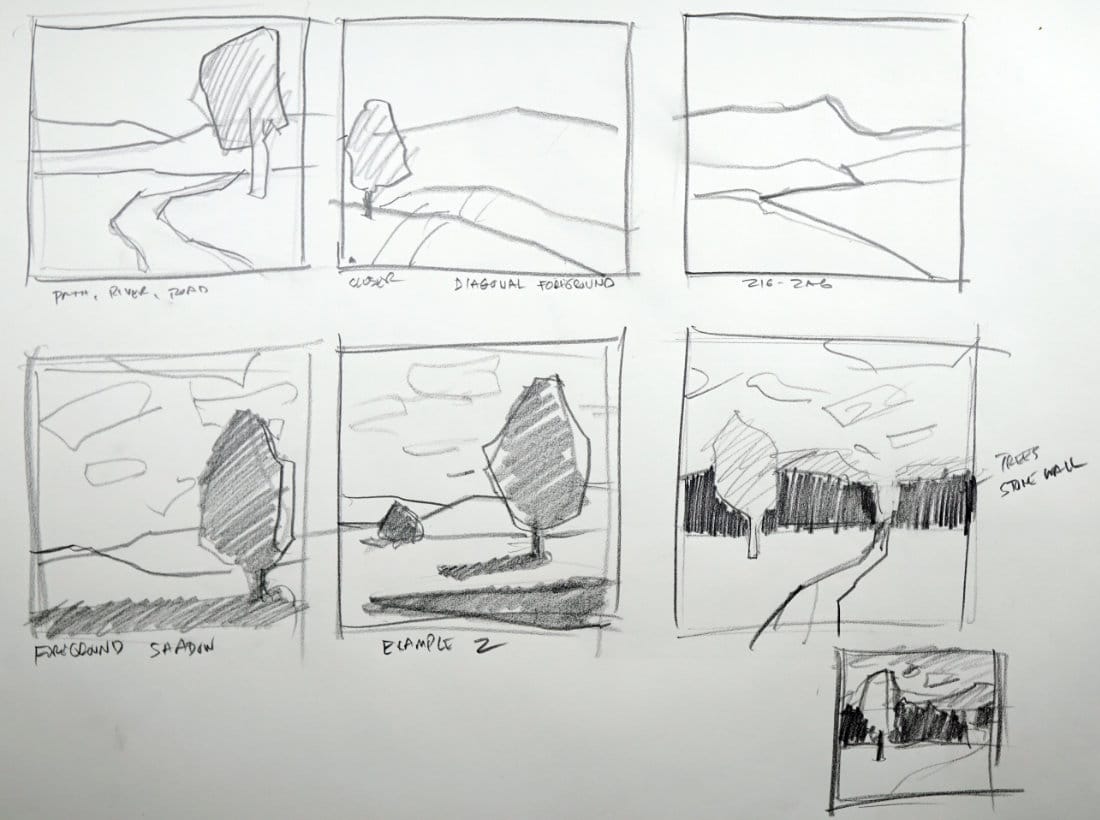Leading the Viewer Into the Painting - Landscape Design
Discover how to lead the viewer into your painting using paths, diagonals, shadows, and zigzags — and avoid common barriers that block depth and flow.

A successful landscape painting invites the viewer inside — it feels open, dynamic, and full of depth. In this lesson, I’ll show several ways to design compositions that pull the viewer into the scene, plus a few common traps that can unintentionally block them out.
This lesson is part of the Acrylic Landscape Painting Fundamentals Course.
The Path, River, or Road
One of the oldest and most reliable ways to lead the viewer into a painting is with a path.
It could be a river, dirt road, or winding trail — anything that starts wide in the foreground and gradually narrows as it moves into the distance.
This tapering shape naturally creates linear perspective, helping the viewer sense depth and distance. It’s a simple but powerful device for visual movement.

The Diagonal Foreground
A diagonal shape in the foreground — like a hill, field edge, or shoreline — also helps lead the viewer in. When one corner of your painting comes forward and the opposite recedes, it automatically creates motion and depth.
The eye tends to follow that diagonal line inward, exploring the space from foreground to background. Try tilting your ground plane or horizon slightly to achieve this subtle pull.
The Zigzag Path
A variation of the diagonal is the zigzag, where shapes or lines alternate direction — maybe a road that turns, or layers of hills overlapping. This creates rhythm and keeps the viewer’s eye engaged as it moves deeper into the painting.
You can exaggerate or simplify the zigzag pattern depending on how dynamic or calm you want the composition to feel.
Foreground Shadows
Another trick is to use a shadow pattern in the foreground. A band of shadow stretching across the front of the scene creates a sense of entry — as if the viewer is standing in the shaded area, looking into the light beyond.
It can be bold or subtle: a diagonal shadow, a tree cast across a road, or even a mysterious dark shape that adds intrigue. Either way, it helps set a mood and guide the eye inward.
What to Avoid: The “Wall” Effect
Sometimes, without realizing it, we block the viewer’s entry into the painting with a solid barrier — a row of trees, a hedge, or a dark horizontal band across the foreground.
This “wall” effect makes the scene feel closed off, like you’re staring at a fence instead of being invited through it.
To fix this:
- Break the barrier with a path, gap, or opening.
- Or crop part of the dark shape so there’s a visual entry point.
Even a small break lets the eye move naturally into the space behind it.
Key Takeaways
- Use paths, rivers, or roads to establish depth.
- Add diagonal or zigzag movement to keep the viewer’s eye exploring.
- Use foreground shadows to create a sense of entry and atmosphere.
- Avoid wall-like shapes that block the viewer’s path.
- Always give the eye a way to move into and through your design.
Course Navigation
Previous Lesson: Light vs Dark: Balancing Asymmetry in Landscape Design
Next Lesson: Composition Types or Landscape Painting
Acrylic Landscape Painting Hub - view all lessons & modules
Learn & Improve Your Acrylic Skills
- Acrylic Hub– Your go-to guide for tutorials, tips, and resources.
- Ultimate Beginner Acrylic Course - Start painting with confidence.
- Subscribe for More Great Content - Get tutorials, tips, and updates straight to your inbox.
- Follow Me on Pinterest - Daily inspiration, tips, and fresh ideas.
Recommended Acrylic Painting Materials
-
Princeton Catalyst Brushes – Flats (#6, #12), Rounds (#4, #8), Fan (#4), Liner Brush
Durable synthetic bristles for versatile acrylic techniques -
Liquitex Heavy Body Acrylic Paint – Essential Colors
Cadmium Yellow, Yellow Ochre, Alizarin Crimson, Cadmium Red Light, Ultramarine Blue, Cobalt Blue, Burnt Sienna, Titanium White -
Winsor & Newton Cotton Canvas
Reliable stretched canvas for studio and plein air work -
Strathmore 400 Series Mixed Media Paper
Heavyweight, acid-free paper for acrylic and mixed media -
Fabriano Artistico 140lb Cold Press Paper
Excellent for acrylic, mixed media, and textured effects -
Blick Multi-Colored Painting Knife Set
Variety of shapes for texture, scraping, and bold strokes - Miscellaneous: Two pint-sized water containers, paper towels (from Home Depot or Walmart)
- Note: I use canvas or sturdy cardboard as my palette — no store-bought palettes needed.




